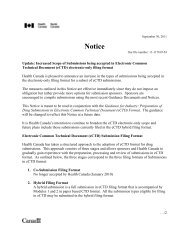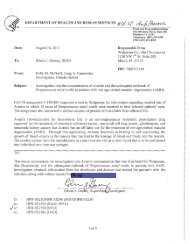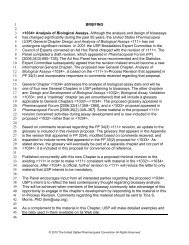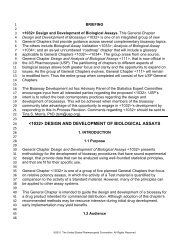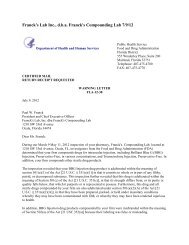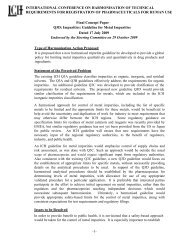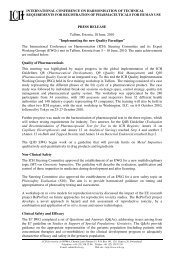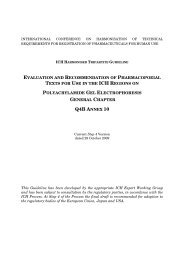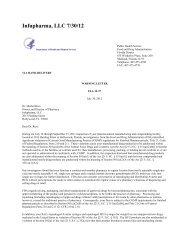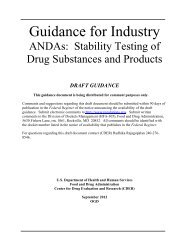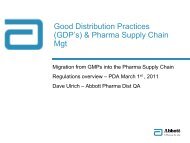BEPBA Bioassay Conference Agenda - IPQ
BEPBA Bioassay Conference Agenda - IPQ
BEPBA Bioassay Conference Agenda - IPQ
Create successful ePaper yourself
Turn your PDF publications into a flip-book with our unique Google optimized e-Paper software.
BEBPA’s 3rd Annual Biological Assay <strong>Conference</strong><br />
Pre-<strong>Conference</strong> Workshop: Practical Tools for the <strong>Bioassay</strong> Scientist<br />
8:15—8:30 Open of Workshop: Organizers’ Comments<br />
Laureen Little, PhD, Principal Consultant, Quality Services<br />
8:30—9:30 Primer for the Statistical Design of Experiments<br />
(DOE)<br />
Simply put, experiments are carried out to obtain unknown<br />
information. Statistical concepts applied to the design of experiments<br />
can make the experiments more efficient, more effective,<br />
and therefore more productive—that is, statistically<br />
designed experiments can obtain the required information with<br />
a minimum expenditure of resources (a desirable business<br />
goal!). This brief introduction will discuss the important topics<br />
of replication to measure and minimize the effects of purely<br />
experimental uncertainty: factor interaction; and the use of<br />
broad designs to minimize uncertainty in the results. Various<br />
classical experimental designs will be introduced.<br />
Dr. Stanley Deming, President, Statistical Designs, USA<br />
9:30-10:15 Design Of Experiments in the Framework of a<br />
Cell Based Potency Assay<br />
Biological assays for measuring the potency of a therapeutic<br />
drug candidate are critical components to monitor its quality<br />
and stability. These potency assays should describe the specific<br />
ability or capacity of a product to achieve a defined biological<br />
effect. In the given example this biological effect is<br />
measured in a virus neutralization assay. In particular, for the<br />
development of this assay, accuracy, precision and window of<br />
the virus neutralization curve had to be optimized as a function<br />
of seven potentially critical factors. The design and the analysis<br />
of these experiments are discussed. For the design of experiments<br />
(DOE) part, some important issues concerning the<br />
randomization scheme, blocking and hard-to-change variables<br />
are highlighted. Additionally, the impact of changing the design<br />
settings before and during experimentation is discussed. For<br />
the analysis part, multiple responses that should be optimized<br />
together if possible are dealt with. The problem of missing data<br />
is also tackled by using multiple imputation techniques. Finally,<br />
the resulting optimal factor settings together with the final<br />
model are tested through additional experiments.<br />
Dr. Katrien Verschueren, Biostatistician, Ablynx, Belgium<br />
10:15—10:45 Morning Break<br />
10:45-11:30 Application of DoE in <strong>Bioassay</strong> Development:<br />
A One Day Simplified Muli-Factorial DoE Approach Addressing<br />
<strong>Bioassay</strong> Robustness<br />
Dr. Hyun (Jun) Kim, Associate Scientist II, MedImmune,<br />
USA<br />
11:30-12:15 Validation of Relative EC50 ELISA Assays<br />
We will discuss a case study for the validation of these types<br />
Three Ways to Register<br />
of ELISAs. The design and outcome for all ICH parameters will<br />
be reviewed together with lessons learned. We will also briefly<br />
discuss the statistical design of the assay and the analysis of<br />
validation data.<br />
Matthew Trickett, Experimental officer, Covance Labs, UK<br />
12:15—1:30 Luncheon<br />
1:30-2:15 Strategies to Reduce Noise-Dependant Censoring<br />
Bias in <strong>Bioassay</strong>s<br />
Bias, like relative potency, can be most efficiently estimated<br />
within-assay. A common result is attenuation of estimated potency<br />
that increases with differences between sample and reference<br />
potency. This is also seen in computer simulation experiments<br />
where attenuation also increases with noise around<br />
the fitted lines or curves, often acting via similarity failures. In<br />
linear model bioassay the noise-induced bias partially depends<br />
on the strategy used to select near-linear portions of the response<br />
curves. Potency bias depends on the assay design,<br />
the potency range, the analysis method, and the variation in<br />
the assay. Careful study of how these combine can inform<br />
many strategic choices in bioassay design, analysis, and use.<br />
Dr. David Lansky, President, Precision <strong>Bioassay</strong><br />
2:15-3:15 Primer: USP Approaches to Similarity and Modeling<br />
for the Bench Scientist<br />
Presenter to be Determined<br />
3:15—3:45 Exhibit/Poster and Refreshment Break<br />
3:45-4:30 Parallelism Testing of Four-parameter Logistic<br />
Curves for <strong>Bioassay</strong>: A Case Study for Implementation of<br />
USP <strong>Bioassay</strong> Guidance<br />
Dr. Hyun (Jun) Kim, Associate Scientist II, MedImmune, USA<br />
4:30-5:15. Detecting "Non-Parallelism" using Residual<br />
Sums of Squares from a Parameter Logistic Model.<br />
Making the reasonable assumption that all wells on a bioassay<br />
plate have been prepared uniformly, it is then reasonable to fit<br />
a four-parameter logistic (4PL) model that has a single upper<br />
asymptote parameter, a single lower asymptote parameter,<br />
and a single slope parameter (common parameters) for reference<br />
standard, control, and test samples applied to the plate;<br />
each sample has it's own "C" parameter (related to its log<br />
[ED50]) in the model. For individual samples that behave similarly,<br />
their average sums of squares of residuals (SSR) are<br />
expected to be approximately the same; for a non-similar (nonparallel)<br />
sample, its SSR is expected to be inflated. Experience<br />
with real samples shows this to be true. The average<br />
SSR is also useful for detecting what appear to be sequential<br />
pipeting errors and "bad" wells on a plate.<br />
Annemarie King, HPA, UK<br />
5:15 End of Workshop<br />
www.BEBPA.org Telephone: +1-916-729-0109<br />
Fax:1-916-729-2602



